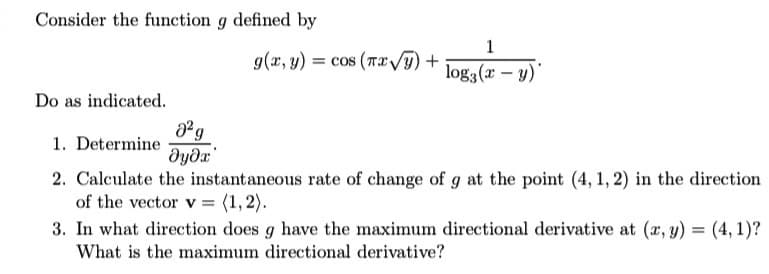Consider the function g defined by 1 g(x, y) = cos (Ta V) + log3 (r – y Do as indicated. 1. Determine 2. Calculate the instantaneous rate of change of g at the point (4, 1, 2) in the direction of the vector v = (1,2). 3. In what direction does g have the maximum directional derivative at (x, y) = (4, 1)? What is the maximum directional derivative?
Consider the function g defined by 1 g(x, y) = cos (Ta V) + log3 (r – y Do as indicated. 1. Determine 2. Calculate the instantaneous rate of change of g at the point (4, 1, 2) in the direction of the vector v = (1,2). 3. In what direction does g have the maximum directional derivative at (x, y) = (4, 1)? What is the maximum directional derivative?
Calculus For The Life Sciences
2nd Edition
ISBN:9780321964038
Author:GREENWELL, Raymond N., RITCHEY, Nathan P., Lial, Margaret L.
Publisher:GREENWELL, Raymond N., RITCHEY, Nathan P., Lial, Margaret L.
Chapter14: Discrete Dynamical Systems
Section14.3: Determining Stability
Problem 13E: Repeat the instruction of Exercise 11 for the function. f(x)=x3+x For part d, use i. a1=0.1 ii...
Related questions
Question

Transcribed Image Text:Consider the function g defined by
1
g(x, y) = cos (Tx V) +
log3 (x – y)
Do as indicated.
1. Determine
2. Calculate the instantaneous rate of change of g at the point (4, 1, 2) in the direction
of the vector v = (1,2).
3. In what direction does g have the maximum directional derivative at (x, y) = (4, 1)?
What is the maximum directional derivative?
Expert Solution
This question has been solved!
Explore an expertly crafted, step-by-step solution for a thorough understanding of key concepts.
Step by step
Solved in 2 steps with 2 images

Recommended textbooks for you

Calculus For The Life Sciences
Calculus
ISBN:
9780321964038
Author:
GREENWELL, Raymond N., RITCHEY, Nathan P., Lial, Margaret L.
Publisher:
Pearson Addison Wesley,

Trigonometry (MindTap Course List)
Trigonometry
ISBN:
9781337278461
Author:
Ron Larson
Publisher:
Cengage Learning

Calculus For The Life Sciences
Calculus
ISBN:
9780321964038
Author:
GREENWELL, Raymond N., RITCHEY, Nathan P., Lial, Margaret L.
Publisher:
Pearson Addison Wesley,

Trigonometry (MindTap Course List)
Trigonometry
ISBN:
9781337278461
Author:
Ron Larson
Publisher:
Cengage Learning